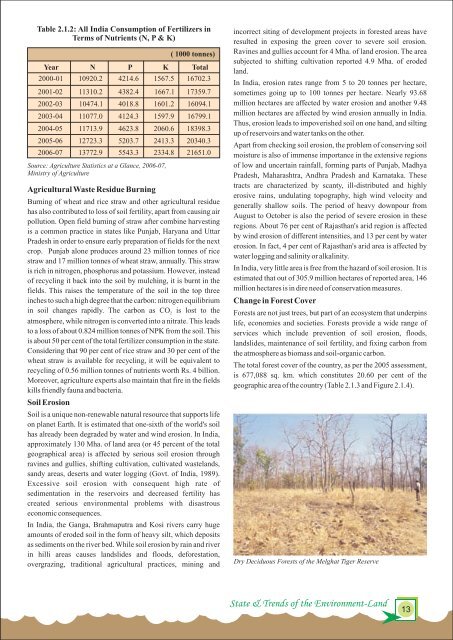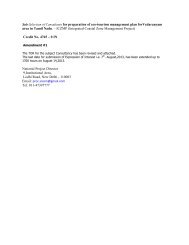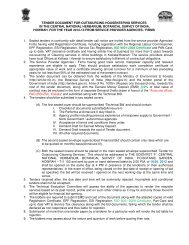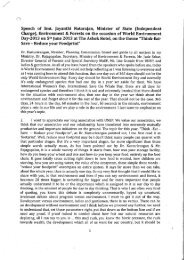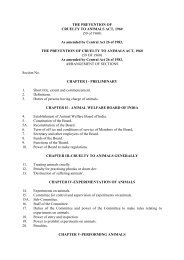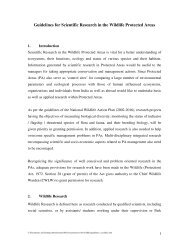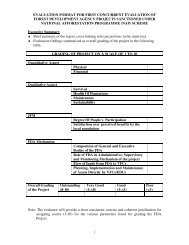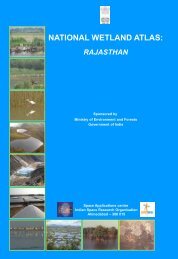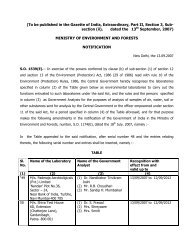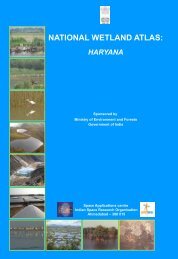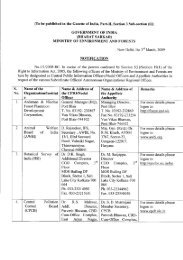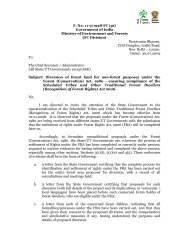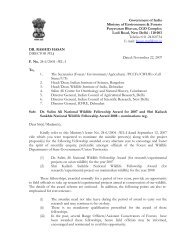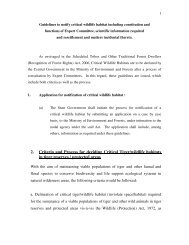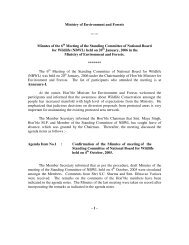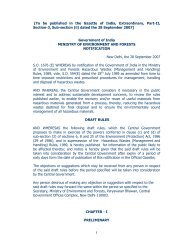lR;eso t;rs - Ministry of Environment and Forests
lR;eso t;rs - Ministry of Environment and Forests
lR;eso t;rs - Ministry of Environment and Forests
Create successful ePaper yourself
Turn your PDF publications into a flip-book with our unique Google optimized e-Paper software.
Table 2.1.2: All India Consumption <strong>of</strong> Fertilize<strong>rs</strong> in<br />
Terms <strong>of</strong> Nutrients (N, P & K)<br />
Source: Agriculture Statistics at a Glance, 2006-07,<br />
<strong>Ministry</strong> <strong>of</strong> Agriculture<br />
Agricultural Waste Residue Burning<br />
Burning <strong>of</strong> wheat <strong>and</strong> rice straw <strong>and</strong> other agricultural residue<br />
has also contributed to loss <strong>of</strong> soil fertility, apart from causing air<br />
pollution. Open field burning <strong>of</strong> straw after combine harvesting<br />
is a common practice in states like Punjab, Haryana <strong>and</strong> Uttar<br />
Pradesh in order to ensure early preparation <strong>of</strong> fields for the next<br />
crop. Punjab alone produces around 23 million tonnes <strong>of</strong> rice<br />
straw <strong>and</strong> 17 million tonnes <strong>of</strong> wheat straw, annually. This straw<br />
is rich in nitrogen, phosphorus <strong>and</strong> potassium. However, instead<br />
<strong>of</strong> recycling it back into the soil by mulching, it is burnt in the<br />
fields. This raises the temperature <strong>of</strong> the soil in the top three<br />
inches to such a high degree that the carbon: nitrogen equilibrium<br />
in soil changes rapidly. The carbon as CO is lost to the<br />
2<br />
atmosphere, while nitrogen is converted into a nitrate. This leads<br />
to a loss <strong>of</strong> about 0.824 million tonnes <strong>of</strong> NPK from the soil. This<br />
is about 50 per cent <strong>of</strong> the total fertilizer consumption in the state.<br />
Considering that 90 per cent <strong>of</strong> rice straw <strong>and</strong> 30 per cent <strong>of</strong> the<br />
wheat straw is available for recycling, it will be equivalent to<br />
recycling <strong>of</strong> 0.56 million tonnes <strong>of</strong> nutrients worth Rs. 4 billion.<br />
Moreover, agriculture experts also maintain that fire in the fields<br />
kills friendly fauna <strong>and</strong> bacteria.<br />
Soil Erosion<br />
( 1000 tonnes)<br />
Year N P K Total<br />
2000-01 10920.2 4214.6 1567.5 16702.3<br />
2001-02 11310.2 4382.4 1667.1 17359.7<br />
2002-03 10474.1 4018.8 1601.2 16094.1<br />
2003-04 11077.0 4124.3 1597.9 16799.1<br />
2004-05 11713.9 4623.8 2060.6 18398.3<br />
2005-06 12723.3 5203.7 2413.3 20340.3<br />
2006-07 13772.9 5543.3 2334.8 21651.0<br />
Soil is a unique non-renewable natural r<strong>eso</strong>urce that supports life<br />
on planet Earth. It is estimated that one-sixth <strong>of</strong> the world's soil<br />
has already been degraded by water <strong>and</strong> wind erosion. In India,<br />
approximately 130 Mha. <strong>of</strong> l<strong>and</strong> area (or 45 percent <strong>of</strong> the total<br />
geographical area) is affected by serious soil erosion through<br />
ravines <strong>and</strong> gullies, shifting cultivation, cultivated wastel<strong>and</strong>s,<br />
s<strong>and</strong>y areas, deserts <strong>and</strong> water logging (Govt. <strong>of</strong> India, 1989).<br />
Excessive soil erosion with consequent high rate <strong>of</strong><br />
sedimentation in the reservoi<strong>rs</strong> <strong>and</strong> decreased fertility has<br />
created serious environmental problems with disastrous<br />
economic consequences.<br />
In India, the Ganga, Brahmaputra <strong>and</strong> Kosi rive<strong>rs</strong> carry huge<br />
amounts <strong>of</strong> eroded soil in the form <strong>of</strong> heavy silt, which deposits<br />
as sediments on the river bed. While soil erosion by rain <strong>and</strong> river<br />
in hilli areas causes l<strong>and</strong>slides <strong>and</strong> floods, deforestation,<br />
overgrazing, traditional agricultural practices, mining <strong>and</strong><br />
incorrect siting <strong>of</strong> development projects in forested areas have<br />
resulted in exposing the green cover to severe soil erosion.<br />
Ravines <strong>and</strong> gullies account for 4 Mha. <strong>of</strong> l<strong>and</strong> erosion. The area<br />
subjected to shifting cultivation reported 4.9 Mha. <strong>of</strong> eroded<br />
l<strong>and</strong>.<br />
In India, erosion rates range from 5 to 20 tonnes per hectare,<br />
sometimes going up to 100 tonnes per hectare. Nearly 93.68<br />
million hectares are affected by water erosion <strong>and</strong> another 9.48<br />
million hectares are affected by wind erosion annually in India.<br />
Thus, erosion leads to impoverished soil on one h<strong>and</strong>, <strong>and</strong> silting<br />
up <strong>of</strong> reservoi<strong>rs</strong> <strong>and</strong> water tanks on the other.<br />
Apart from checking soil erosion, the problem <strong>of</strong> conserving soil<br />
moisture is also <strong>of</strong> immense importance in the extensive regions<br />
<strong>of</strong> low <strong>and</strong> uncertain rainfall, forming parts <strong>of</strong> Punjab, Madhya<br />
Pradesh, Maharashtra, Andhra Pradesh <strong>and</strong> Karnataka. These<br />
tracts are characterized by scanty, ill-distributed <strong>and</strong> highly<br />
erosive rains, undulating topography, high wind velocity <strong>and</strong><br />
generally shallow soils. The period <strong>of</strong> heavy downpour from<br />
August to October is also the period <strong>of</strong> severe erosion in these<br />
regions. About 76 per cent <strong>of</strong> Rajasthan's arid region is affected<br />
by wind erosion <strong>of</strong> different intensities, <strong>and</strong> 13 per cent by water<br />
erosion. In fact, 4 per cent <strong>of</strong> Rajasthan's arid area is affected by<br />
water logging <strong>and</strong> salinity or alkalinity.<br />
In India, very little area is free from the hazard <strong>of</strong> soil erosion. It is<br />
estimated that out <strong>of</strong> 305.9 million hectares <strong>of</strong> reported area, 146<br />
million hectares is in dire need <strong>of</strong> conservation measures.<br />
Change in Forest Cover<br />
<strong>Forests</strong> are not just trees, but part <strong>of</strong> an ecosystem that underpins<br />
life, economies <strong>and</strong> societies. <strong>Forests</strong> provide a wide range <strong>of</strong><br />
services which include prevention <strong>of</strong> soil erosion, floods,<br />
l<strong>and</strong>slides, maintenance <strong>of</strong> soil fertility, <strong>and</strong> fixing carbon from<br />
the atmosphere as biomass <strong>and</strong> soil-organic carbon.<br />
The total forest cover <strong>of</strong> the country, as per the 2005 assessment,<br />
is 677,088 sq. km. which constitutes 20.60 per cent <strong>of</strong> the<br />
geographic area <strong>of</strong> the country (Table 2.1.3 <strong>and</strong> Figure 2.1.4).<br />
Dry Deciduous <strong>Forests</strong> <strong>of</strong> the Melghat Tiger Reserve<br />
State & Trends <strong>of</strong> the <strong>Environment</strong>-L<strong>and</strong><br />
13


